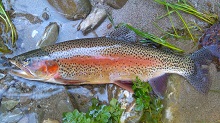Brown Trout Adapt to Polluted Water
Canadian Angling. com (August 21, 2013) Brown trout have been found to adapt to contaminated water, in a recent study by King’s College and London University of Exeter (England). They found that a population of brown trout is surviving in the River Hayle in Cornwall, England. This river has extremely high concentrations of metals and they found out that these levels would quickly kill healthy fish from other unpolluted sites. They believe that they are able to adapt because of their genes.
The research was led by T. Uren Webster, Dr R. van Aerle and Dr E Santos from the University of Exeter and Dr N Bury from King’s College London, and has been published in the journal Environmental Science & Technology.
The researchers looked at trout living in the River Hayle and compared them to a clean area in the River Teign. They took samples from both sites and found that the brown trout in the River Hayle had metals: 19 times in the kidney and 34 times in the liver and 63 times in the gill compared to the River Hayle brown trout. This showed that over time the population of brown trout had adapted to the extreme metal concentrations.
The researchers then looked at certain protein levels in the brown trout, to see if these levels were at normal levels. They looked specifically at proteins that are responsible for storing, binding and detoxifying these metals. They found that these proteins were highly expressed in the River Hayle brown trout.
Normally these metals damage the kidneys, liver and gills and this causes an inbalance in the ions in the body, quickly causing death of the fish but these brown trout showed changes in the genes responsible for balancing these ions in the body. They also found a small increase in anti-oxidant levels.
“The work demonstrates that this population of brown trout has developed strategies for dealing with the metal pollution in the water and accumulation in their tissues avoiding the lethal damage that such concentrations of metals would normally cause.” said T. Uren Webster. If we can understand how these brown trout have adapted to this polluted river, we can then stabilize and increase fish populations in other highly polluted regions.
Dr Santos said: “The story of the brown trout in the river Hayle is a fascinating one, demonstrating its resilience and its ability to defeat the odds and tolerate the challenges imposed upon them as a result of human activities. Many aspects of this story remain untold: we do not know how or when this tolerance has arisen, and, most importantly, we do not know what the future holds for them if they are challenged with further stressors in their environment. But we know that such populations need careful management; if the Hayle brown trout, with their unique physiology, were to be lost, it is possible that this river may never be home to brown trout again. Therefore, understanding the relationship of fish with their environment is a crucial requirement to effectively manage and protect our aquatic ecosystems.”
Dr Bury said: “Cornwall has a rich history of mining activity. Despite the cessation of the majority of this activity in the 19th and 20th centuries a number of rivers and estuaries, still possess elevated metals. Brown trout are extremely sensitive to metals when tested in the laboratory. However, biology is remarkable and adaptable, and it is astonishing that trout are able to survive and flourish in the river Hayle. It may be that this population is unique and an important component of the genetic diversity of brown trout.”
Wayne Sheridan for Canadian Angling.com



